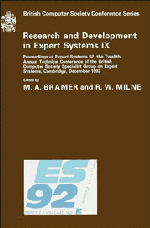Book contents
- Frontmatter
- Contents
- Preface
- Introduction
- CONSULTANT: providing advice for the machine learning toolbox
- A methods model for the integration of KBS and conventional information technology
- KBS methodology as a framework for co-operative working
- Project management for the evolutionary development of expert systems
- The specification and development of rule-based expert systems
- Towards a method for multi-agent system design
- Jigsaw: configuring knowledge acquisition tools
- On the relationship between repertory grid and term subsumption knowledge structures: theory practice tools
- Strategy maze: an on-line tool for support management of the knowledge acquisition process
- Concurrent engineering using collaborating truth maintenance systems
- Ockham's razor as a gardening tool
- A designer's consultant
- Fairness of attribute selection in probabilistic induction
- An application of case-based expert system technology to dynamic job-shop scheduling
- Neural network design via LP
- KEshell2: an intelligent learning data base system
- Approaches to self-explanation and system visibility in the context of application tasks
- An object oriented approach to distributed problem solving
- Intelligent user interface for multiple application systems
- Combining qualitative and quantitative information for temporal reasoning
- Documents as expert systems
Combining qualitative and quantitative information for temporal reasoning
Published online by Cambridge University Press: 04 August 2010
- Frontmatter
- Contents
- Preface
- Introduction
- CONSULTANT: providing advice for the machine learning toolbox
- A methods model for the integration of KBS and conventional information technology
- KBS methodology as a framework for co-operative working
- Project management for the evolutionary development of expert systems
- The specification and development of rule-based expert systems
- Towards a method for multi-agent system design
- Jigsaw: configuring knowledge acquisition tools
- On the relationship between repertory grid and term subsumption knowledge structures: theory practice tools
- Strategy maze: an on-line tool for support management of the knowledge acquisition process
- Concurrent engineering using collaborating truth maintenance systems
- Ockham's razor as a gardening tool
- A designer's consultant
- Fairness of attribute selection in probabilistic induction
- An application of case-based expert system technology to dynamic job-shop scheduling
- Neural network design via LP
- KEshell2: an intelligent learning data base system
- Approaches to self-explanation and system visibility in the context of application tasks
- An object oriented approach to distributed problem solving
- Intelligent user interface for multiple application systems
- Combining qualitative and quantitative information for temporal reasoning
- Documents as expert systems
Summary
Introduction
Time is an important aspect of any intelligent knowledge representation. This has led to a rising need for reasoning about time in various applications of artificial intelligence such as process control or decision making. Different schemes for temporal information representation have been proposed so far. A natural way to refer to a temporal event consists in making references to a clock providing a quantitative or numerical representation of time, as well as several concepts such as duration and calendar. However, a clock reference is not always available or relevant. In such cases, a qualitative (symbolic) representation of time can be used to describe the situations in question.
In spite of the different representations of temporal information proposed, most are not completely satisfactory. Looking at existing work, Allen's representation [Allen 83] is a very powerful representation in describing the relativity between intervals. Vilain and kautz proposed a subinterval algebra [Vilain & Kautz 86], Ghallab and Mounir [Ghallab & Mounir 89] based on the notion of subinterval algebara, have also proposed a model with symbolic relations but within the framework of subinterval algebra. However, these models don't address numerical aspect of time. On the other hand, the time map of Dean and McDermott [Dean & McDermott 87], Rit geometrical model [Rit 86] and the temporal constraint networks [Dechter, Meiri & Pearl 91] are designed for handling metric information and can't handle in a good way symbolic ones.
- Type
- Chapter
- Information
- Research and Development in Expert Systems IX , pp. 317 - 330Publisher: Cambridge University PressPrint publication year: 1993



